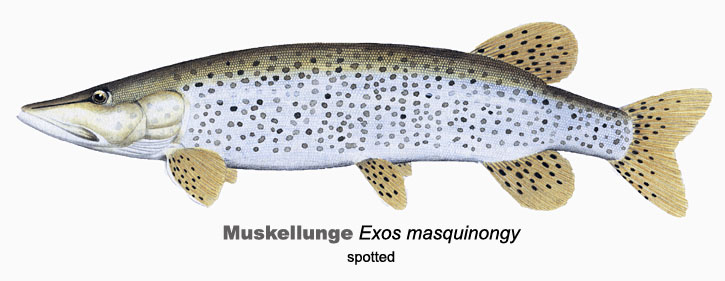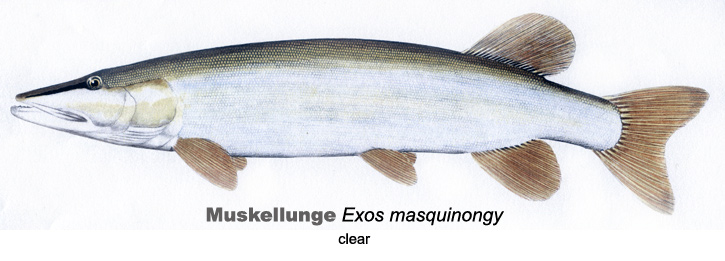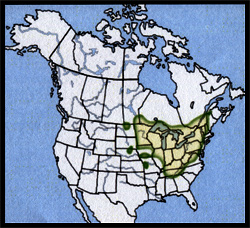Muskellunge, May 2013, Fish of the Month!

 Muskellunge
Muskellunge
Esox masquinongy
Local Names:
Muskie, Great pike, Lunge, Mascalonge, Maskinonge, Tiger, White pickerel
Average Size:
28 to 40 inches
6 to 20 pounds
and occasionally much larger
Distinguishing Field Marks:
Color and color pattern are reliable distinguishing field marks for this species. (See the illustration.)
-
There are 3 basic Muskellunge color-marking patterns: barred, spotted, and clear, (see illustrations) and occasional intermediates as well.
-
The head of the Muskellunge is large with an elongated snout, although the upper jaw extends only to the rear edge of the eye. From the top, the head is very wide and duck bill-shaped.
-
Only the upper portions of the cheeks and gill covers are scaled. The top of the head has no scales.
-
The head of the Northern pike is typically marked with diagonal or horizontal lines, while the head of the Muskellunge is not.

-
The eyes are large and set high on each side of the head.
-
The bottom of the lower jaws usually have 6 to 9 sensory pores on each side and rarely 5 or 10 on one side only.
-
The caudal fin is deeply forked with pointed tips on both lobes.
North American Range:
Map to the right shows approximate range in North America.
Biology:
Typical of this family, in spring, often shortly after “ice-out,” Muskellunge seek shallow flooded areas of the waters where they live for spawning. These areas will later grow into dense weed beds.
A large female Muskellunge will pair with one or two smaller males as they frequently cruise over the chosen spawning site, over a period of several days. The average number of eggs carried by each adult female Muskellunge is 120,000. The fertilized eggs simply sink into the bottom vegetation where they incubate for 8 to 14 days. After hatching, the fry remain dormant in the weeds for a period of about 10 days. They then begin actively feeding. Muskellunge often reach 6 inches in length within 10 weeks, and 10 to 12 inches by late fall of their first year. Muskellunge can attain life spans of up to 20 years.
Diet:
As soon as the yolk sac is consumed and Muskellunge begin actively feeding, their diet is made up of larger invertebrates and, in as little as 3 weeks, includes small fish. Adult Muskellunge feed almost exclusively on other fish which they take in a swift charge. They then return to the cover from which they struck and turn their meal so it can be ingested head first, thereby folding any spines back and avoiding injury to themselves.
In addition to fish, adult Muskellunge will take any prey that enters their territory including frogs, crayfish, waterfowl, and aquatic and terrestrial mammals.
Locating and Fly-Fishing for Muskellunge:
Adult Muskellunge are solitary animals, selecting a protected territory and only moving from that to take food as it becomes available, so still fishing for Muskellunge is seldom if ever productive.
The heavier fly-rodding gear is necessary to present the large flies needed to interest these fish. As is the case with salt-water fly fishing, the number of fly-rodders devoting time to this species is increasing. If you do want to join the Muskellunge fly-anglers club, you’ll want to leave outfits rated for anything less than 8 weight at home. More appropriate for the task at hand are 9 to 11 weight outfits. If you’re coming from coastal to inland waters and think Muskellunge’d be a good replacement for Striped bass, Bluefish, Channel bass, etc., you’re likely to feel right at home in Musky-land. But do not expect to ever encounter a school of these fish, or even a small group of them. Adult Muskellunge, and increasingly so as they grow larger, are solitary fish. In rivers, it’s possible to find somewhat denser aggregations of (usually smaller) Muskellunge, but they’re known as “the fish of a thousand casts” at least in part because they are generally few and far between. You’ll want big flies for these fish: size 2 is about as small as you’re advised to go and still be in the Muskellunge attractive range (this is also true for Northern pike). You’ll want the whole fly to be at least 6 inches long. Patterns? Probably the most versatile of the big fish freshwater basic patterns is the Dahlberg Diver. These can be fished at, near, or under the water’s surface (or a mix of those three). Because they’re tied on rather short-shank hooks at the fly’s head, these flies are relatively light for their size, and therefore relatively easy to cast. Possible mutations of the original pattern can be made in as many colors and material mixes as tickle the tyer’s fancy. Because all members of this small family of fish love “structure,” especially weeds, tying a weed guard into the fly is a good idea. For both Northern pike and Muskellunge (especially) to avoid losing every fish to a tooth-cut leader, tie or crimp in a 6 to 8 inch section of either heavy monofilament or wire leader (a “shock tippet”) between the leader and fly. In anything but wadeable rivers, you’ll need a boat to cover enough water to even have a chance at hooking a Muskellunge. Now, once you’ve got your Muskellunge fly-fishing “ducks in a row,” all you need to do is get onto the water, get yourself into casting range of some likely Muskie-looking water and begin your possibly very long quest. Muskies are most likely to stake out a territory near a log, large tree-stump, submerged boulder, or dense weed-bed. Quietly and slowly work your way along these types of water, casting as you go……casting, casting, casting, and casting. You might want to consider your time spent in this form of fly-fishing your Muskie Meditations.
Hooked Muskellunge are powerful fighters. Their long length and heavy weight coupled with surging runs for shelter and often spectacular jumps, attest to their reputation as superb game fish.
If you are already an avid Muskellunge angler you certainly know where, when, and how you like to fish for them. If you have only recently discovered this aspect of the sport, you are well advised to do a thorough on-line search for locations, seasons, guides, and outfitters to make your outings as successful as possible. For anyone seeking these legendary game fish, studying state and provincial regulations is a requirement.
Significance to Humans:
In the late 19th century, Muskellunge were commercially taken and sold by the thousands of pounds. By the early 20th century, interest from anglers and declining Muskellunge populations sealed the species’ future as strictly a sport fish. As one of North America’s largest freshwater fish, and one of the most challenging to catch, it is likely that the Muskellunge will remain exclusively a game species for generations to come.
Status:
Declining in some regions, notably the fabled waters of the Saint Lawrence River, while maintaining in others, in part through hatchery stocking programs.






